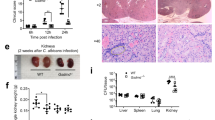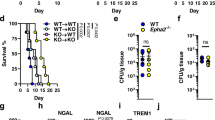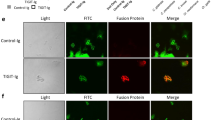Abstract
Disseminated candidiasis has become one of the leading causes of hospital-acquired blood stream infections with high mobility and mortality. However, the molecular basis of host defense against disseminated candidiasis remains elusive, and treatment options are limited. Here we report that the E3 ubiquitin ligase CBLB directs polyubiquitination of dectin-1 and dectin-2, two key pattern-recognition receptors for sensing Candida albicans, and their downstream kinase SYK, thus inhibiting dectin-1- and dectin-2-mediated innate immune responses. CBLB deficiency or inactivation protects mice from systemic infection with a lethal dose of C. albicans, and deficiency of dectin-1, dectin-2, or both in Cblb−/− mice abrogates this protection. Notably, silencing the Cblb gene in vivo protects mice from lethal systemic C. albicans infection. Our data reveal that CBLB is crucial for homeostatic control of innate immune responses mediated by dectin-1 and dectin-2. Our data also indicate that CBLB represents a potential therapeutic target for protection from disseminated candidiasis.
This is a preview of subscription content, access via your institution
Access options
Subscribe to this journal
Receive 12 print issues and online access
$209.00 per year
only $17.42 per issue
Buy this article
- Purchase on Springer Link
- Instant access to full article PDF
Prices may be subject to local taxes which are calculated during checkout






Similar content being viewed by others
References
Brown, G.D. et al. Hidden killers: human fungal infections. Sci. Transl. Med. 4, 165rv13 (2012).
Taylor, P.R. et al. Dectin-1 is required for β-glucan recognition and control of fungal infection. Nat. Immunol. 8, 31–38 (2007).
Saijo, S. et al. Dectin-2 recognition of α-mannans and induction of TH17 cell differentiation is essential for host defense against Candida albicans. Immunity 32, 681–691 (2010).
Zhu, L.L. et al. C-type lectin receptors dectin-3 and dectin-2 form a heterodimeric pattern-recognition receptor for host defense against fungal infection. Immunity 39, 324–334 (2013).
Hernández-Santos, N. & Gaffen, S.L. TH17 cells in immunity to Candida albicans. Cell Host Microbe 11, 425–435 (2012).
Liu, Q., Zhou, H., Langdon, W.Y. & Zhang, J. E3 ubiquitin ligase Cblb in innate and adaptive immunity. Cell Cycle 13, 1875–1884 (2014).
Bachmaier, K. et al. Negative regulation of lymphocyte activation and autoimmunity by the molecular adaptor Cblb. Nature 403, 211–216 (2000).
Jeon, M.S. et al. Essential role of the E3 ubiquitin ligase Cblb in T cell anergy induction. Immunity 21, 167–177 (2004).
Qiao, G. et al. T cell receptor–induced NF-κB activation is negatively regulated by E3 ubiquitin ligase Cblb. Mol. Cell. Biol. 28, 2470–2480 (2008).
Li, D. et al. Cutting edge: Cblb: one of the key molecules tuning CD28- and CTLA-4-mediated T cell co-stimulation. J. Immunol. 173, 7135–7139 (2004).
Zhang, J. et al. Cutting edge: regulation of T cell activation threshold by CD28 co-stimulation through targeting Cblb for ubiquitination. J. Immunol. 169, 2236–2240 (2002).
Guo, H. et al. E3 ubiquitin ligase Cblb regulates Pten via Nedd4 in T cells independently of its ubiquitin ligase activity. Cell Rep. 1, 472–482 (2012).
Qiao, G. et al. T cell activation threshold regulated by E3 ubiquitin ligase Cblb determines fate of inducible regulatory T cells. J. Immunol. 191, 632–639 (2013).
Qiao, G. et al. E3 ubiquitin ligase Cblb suppresses proallergic T cell development and allergic airway inflammation. Cell Rep. 6, 709–723 (2014).
Brown, G.D. Dectin-1: a signaling non-TLR pattern-recognition receptor. Nat. Rev. Immunol. 6, 33–43 (2006).
Yoshitomi, H. et al. A role for fungal β-glucans and their receptor dectin-1 in the induction of autoimmune arthritis in genetically susceptible mice. J. Exp. Med. 201, 949–960 (2005).
Bahn, Y.S. & Sundstrom, P. CAP1, an adenylate cyclase-associated protein gene, regulates bud–hypha transitions, filamentous growth, and cyclic AMP levels and is required for virulence of Candida albicans. J. Bacteriol. 183, 3211–3223 (2001).
Hohl, T.M. & Feldmesser, M. Aspergillus fumigatus: principles of pathogenesis and host defense. Eukaryot. Cell 6, 1953–1963 (2007).
Steele, C. et al. The β-glucan receptor dectin-1 recognizes specific morphologies of Aspergillus fumigatus. PLoS Pathog. 1, e42 (2005).
Gersuk, G.M., Underhill, D.M., Zhu, L. & Marr, K.A. Dectin-1 and TLRs permit macrophages to distinguish between different Aspergillus fumigatus cellular states. J. Immunol. 176, 3717–3724 (2006).
Rivera, A. et al. Dectin-1 diversifies Aspergillus fumigatus–specific T cell responses by inhibiting T helper type 1 CD4 T cell differentiation. J. Exp. Med. 208, 369–381 (2011).
Hise, A.G. et al. An essential role for the NLRP3 inflammasome in host defense against the human fungal pathogen Candida albicans. Cell Host Microbe 5, 487–497 (2009).
Gringhuis, S.I. et al. Dectin-1 is an extracellular pathogen sensor for the induction and processing of IL-1β via a noncanonical caspase-8 inflammasome. Nat. Immunol. 13, 246–254 (2012).
Smeekens, S.P. et al. An anti-inflammatory property of Candida albicans β-glucan: induction of high levels of interleukin-1 receptor antagonist via a dectin-1–CR3 independent mechanism. Cytokine 71, 215–222 (2015).
Kang, P.B. et al. The human macrophage mannose receptor directs Mycobacterium tuberculosis lipoarabinomannan-mediated phagosome biogenesis. J. Exp. Med. 202, 987–999 (2005).
Rajaram, M.V. et al. Mycobacterium tuberculosis lipomannan blocks TNF biosynthesis by regulating macrophage MAPK-activated protein kinase 2 (MK2) and microRNA miR-125b. Proc. Natl. Acad. Sci. USA 108, 17408–17413 (2011).
Brown, G.D. Innate antifungal immunity: the key role of phagocytes. Annu. Rev. Immunol. 29, 1–21 (2011).
Hardison, S.E. & Brown, G.D. C-type lectin receptors orchestrate antifungal immunity. Nat. Immunol. 13, 817–822 (2012).
Osorio, F. & Reis e Sousa, C. Myeloid C-type lectin receptors in pathogen recognition and host defense. Immunity 34, 651–664 (2011).
Kerscher, B., Willment, J.A. & Brown, G.D. The dectin-2 family of C-type lectin-like receptors: an update. Int. Immunol. 25, 271–277 (2013).
Miyake, Y. et al. C-type lectin MCL is an FcR-γ-coupled receptor that mediates the adjuvanticity of mycobacterial cord factor. Immunity 38, 1050–1062 (2013).
Sato, K. et al. Dectin-2 is a pattern-recognition receptor for fungi that couples with the Fc receptor gamma chain to induce innate immune responses. J. Biol. Chem. 281, 38854–38866 (2006).
Sohn, H.W., Gu, H. & Pierce, S.K. Cblb negatively regulates B cell antigen receptor signaling in mature B cells through ubiquitination of the tyrosine kinase Syk. J. Exp. Med. 197, 1511–1524 (2003).
Kojo, S. et al. Mechanisms of NKT cell anergy induction involve Cblb-promoted monoubiquitination of CARMA1. Proc. Natl. Acad. Sci. USA 106, 17847–17851 (2009).
Oksvold, M.P., Dagger, S.A., Thien, C.B. & Langdon, W.Y. The Cblb RING finger domain has a limited role in regulating inflammatory cytokine production by IgE-activated mast cells. Mol. Immunol. 45, 925–936 (2008).
Sorkin, A. & Von Zastrow, M. Signal transduction and endocytosis: close encounters of many kinds. Nat. Rev. Mol. Cell Biol. 3, 600–614 (2002).
Haglund, K. et al. Multiple monoubiquitination of RTKs is sufficient for their endocytosis and degradation. Nat. Cell Biol. 5, 461–466 (2003).
Lin, Q. et al. HECT E3 ubiquitin ligase Nedd4-1 ubiquitinates ACK and regulates epidermal growth factor (EGF)-induced degradation of EGF receptor and ACK. Mol. Cell. Biol. 30, 1541–1554 (2010).
Hernanz-Falcón, P., Joffre, O., Williams, D.L. & Reis e Sousa, C. Internalization of dectin-1 terminates induction of inflammatory responses. Eur. J. Immunol. 39, 507–513 (2009).
Nicola, A.M., Casadevall, A. & Goldman, D.L. Fungal killing by mammalian phagocytic cells. Curr. Opin. Microbiol. 11, 313–317 (2008).
Brown, A.J., Haynes, K. & Quinn, J. Nitrosative and oxidative stress responses in fungal pathogenicity. Curr. Opin. Microbiol. 12, 384–391 (2009).
Wells, C.A. et al. The macrophage-inducible C-type lectin, Mincle, is an essential component of the innate immune response to Candida albicans. J. Immunol. 180, 7404–7413 (2008).
van de Veerdonk, F.L. et al. The macrophage mannose receptor induces IL-17 in response to Candida albicans. Cell Host Microbe 5, 329–340 (2009).
Cambi, A. et al. The C-type lectin DC-SIGN (CD209) is an antigen-uptake receptor for Candida albicans on dendritic cells. Eur. J. Immunol. 33, 532–538 (2003).
Goodridge, H.S., Underhill, D.M. & Touret, N. Mechanisms of Fc receptor and dectin-1 activation for phagocytosis. Traffic 13, 1062–1071 (2012).
Dupré-Crochet, S., Erard, M. & Nüβe, O. ROS production in phagocytes: why, when, and where? J. Leukoc. Biol. 94, 657–670 (2013).
Underhill, D.M., Rossnagle, E., Lowell, C.A. & Simmons, R.M. Dectin-1 activates Syk tyrosine kinase in a dynamic subset of macrophages for reactive oxygen production. Blood 106, 2543–2550 (2005).
Swamydas, M., Luo, Y., Dorf, M.E. & Lionakis, M.S. Isolation of mouse neutrophils. Curr. Protoc. Immunol. 110, 3.20 (2015).
Wirnsberger, G. et al. Jagunal homolog 1 is a critical regulator of neutrophil function in fungal host defense. Nat. Genet. 46, 1028–1033 (2014).
Acknowledgements
We thank J.M. Penninger (University of Toronto) for providing Cblb−/− mice, Y. Iwakura (Tokyo University of Science) for providing Clec4n−/− mice, S. Lipkowitz (National Cancer Institute, US National Institutes of Health) for providing Cblb constructs, X. Lin (MD Anderson Cancer Center) for providing the antibody to mouse dectin-3 and Card9−/− bone marrow cells, P.R. Sundstrom (Dartmouth University) for providing the C. albicans cap1 mutant, and L.D. Chaves (University at Buffalo) for flow cytometric analysis of myeloid cells in the kidneys. We also thank A. Lovett-Racke (Ohio State University) for her advice on in vivo Cblb-knockdown experiments. This work was supported by the US National Institutes of Health (grants R01 AI090901, R01 AI123253, and R21 AI117547; all to J.Z.), the American Heart Association (AHA Great Rivers Associate Grant-in-Aid grant 16GRNT26990004; J.Z.), a start-up fund from the Ohio State University College of Medicine (J.Z.), and the Wellcome Trust (G.D.B.).
Author information
Authors and Affiliations
Contributions
Y.X. performed most of experiments and analyzed the data; J.T., H.G., Y.Z., R.T., S.O., Q.Z., and B.T.L. performed some in vitro and in vivo experiments; C.A.R. helped design the research, analyzed and interpreted the data, and edited the manuscript; M.V.S.R. performed experiments with human macrophages; L.S.S., M.V.S.R., and J.Z. designed human macrophage experiments and edited the manuscript; L.T. helped design kidney experiments and performed data analysis; G.D.B. provided Clec7a−/− mice; W.Y.L. provided CblbC373A knock-in mice and edited the manuscript; and J.Z. conceived and planned the research, analyzed data and wrote the manuscript.
Corresponding author
Ethics declarations
Competing interests
The authors declare no competing financial interests.
Supplementary information
Supplementary Text and Figures
Supplementary Figures 1–10 (PDF 8416 kb)
Rights and permissions
About this article
Cite this article
Xiao, Y., Tang, J., Guo, H. et al. Targeting CBLB as a potential therapeutic approach for disseminated candidiasis. Nat Med 22, 906–914 (2016). https://doi.org/10.1038/nm.4141
Received:
Accepted:
Published:
Issue Date:
DOI: https://doi.org/10.1038/nm.4141
This article is cited by
-
Phagosomal signalling of the C-type lectin receptor Dectin-1 is terminated by intramembrane proteolysis
Nature Communications (2022)
-
DOCK2 regulates antifungal immunity by regulating RAC GTPase activity
Cellular & Molecular Immunology (2022)
-
TRIM31 facilitates K27-linked polyubiquitination of SYK to regulate antifungal immunity
Signal Transduction and Targeted Therapy (2021)
-
Punicalagin triggers ergosterol biosynthesis disruption and cell cycle arrest in Cryptococcus gattii and Candida albicans
Brazilian Journal of Microbiology (2020)
-
CARD–BCL-10–MALT1 signalling in protective and pathological immunity
Nature Reviews Immunology (2019)



